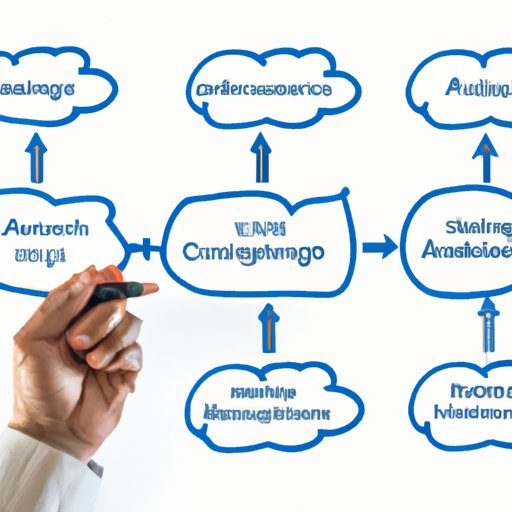I. Introduction
Cloud architecture has become the go-to infrastructure approach for modern businesses. With its flexibility, scalability, and cost-effectiveness, cloud architecture has transformed the way businesses operate. In this article, we will explore the best definition of cloud architecture and its importance and benefits in modern business environments. Whether you are a business owner or IT professional, this guide will provide you with the necessary knowledge to understand and implement cloud architecture effectively.
II. Understanding the Basics of Cloud Architecture: A Guide for Beginners
Cloud architecture is the design and implementation of an IT infrastructure that enables businesses to access data storage, computing power, and application development tools through the internet. Cloud architecture includes various components such as servers, databases, networks, and software. The primary benefit of cloud architecture is that it removes the need for businesses to build and maintain their IT infrastructure.
Cloud architecture has many benefits for businesses, including increased efficiency, reduced costs, and improved data security. Unlike traditional IT infrastructure, cloud architecture enables businesses to use computing power and storage on-demand, allowing for more flexibility and agility in operations.
The main difference between cloud architecture and traditional IT infrastructure is that the former uses a scalable, shared, and on-demand infrastructure model, while the latter often relies on physical hardware that is owned, operated, and maintained by the business.
III. The Importance of Cloud Architecture in Modern Business Environments
Cloud architecture has become increasingly important for businesses looking to stay competitive in a fast-paced, digital world. With cloud architecture, businesses can easily scale their operations up or down depending on their needs. It enables businesses to be more agile, responsive, and efficient.
Cloud architecture also provides businesses with increased flexibility, enabling them to access data from anywhere, at any time, using any device. This enables businesses to take their operations fully mobile, which is essential in today’s mobile-first world. Additionally, cloud architecture can help businesses store, process, and analyze data more efficiently, which is crucial for staying competitive in today’s data-driven economy.
Real-world examples of businesses that have benefited from cloud architecture include Netflix, Airbnb, and Dropbox. These businesses have all seen significant improvements in operational efficiency and cost-effectiveness as a result of implementing cloud architecture.
IV. How Cloud Architecture Enables Scalable and Cost-effective IT Infrastructure
Scalability is one of the most critical benefits of cloud architecture. Cloud architecture enables businesses to scale their operations up or down easily, depending on their needs. This means that businesses can quickly adjust their operations to reflect changes in demand without significant capital investment.
Cost-effectiveness is another critical benefit of cloud architecture. By using a shared infrastructure model, cloud architecture can be much more cost-effective than traditional IT infrastructure. Additionally, cloud architecture enables businesses to reduce their IT infrastructure costs by minimizing the need for hardware, software, and maintenance costs.
Real-world case studies of businesses that have realized these benefits include GE Oil & Gas, which saved $150 million through the implementation of cloud architecture, and Scholastic, which saved $2.5 million in IT costs annually through cloud architecture.
V. A Comprehensive Definition of Cloud Architecture: What It Is and How It Works
Cloud architecture is a comprehensive set of solutions that enable businesses to store and process data, host applications, and more on the internet. Cloud architecture is built on the principles of scalability, flexibility, agility, and cost-effectiveness. The architecture is made up of cloud service providers, who provide various services such as infrastructure, storage, and applications, and cloud consumers, who use these services to build their IT infrastructure and applications.
Cloud architecture is designed to be flexible and adaptable, enabling businesses to make their IT infrastructure as dynamic as possible. It is built on the principles of abstraction, automation, and on-demand computing, enabling businesses to access resources as needed, and freeing developers from infrastructure tasks and operational maintenance.

VI. Key Principles for Designing Effective Cloud Architecture
When designing cloud architecture, businesses must consider key factors such as scalability, security, performance, and cost-effectiveness. Scalability is essential because it enables businesses to adjust their cloud infrastructure as needed. Security is another critical factor to consider, as cloud architecture can be vulnerable to cyber-attacks and data breaches. Performance is also important, as it can impact the user experience and the success of cloud-based applications.
Some best practices for designing effective cloud architecture include selecting the right provider, using multiple cloud service providers, using containers, and limiting dependencies. Real-world examples of businesses that have successfully designed and implemented cloud architecture include Netflix, which has built an entirely cloud-based architecture, and GE, which has reduced its data center footprint by over 90% through the implementation of cloud architecture.
VII. Exploring the Future of Cloud Architecture: Emerging Trends and Technologies
Cloud architecture is continuously evolving, and there are several emerging trends and technologies that are shaping its future. These include serverless computing, edge computing, and hybrid cloud architecture. Serverless computing enables businesses to deploy applications without worrying about the underlying infrastructure, making it more cost-effective and efficient. Edge computing brings the computing power closer to the data source, enabling faster processing and response times. Hybrid cloud architecture, on the other hand, enables businesses to use a mix of cloud and traditional infrastructure, providing both flexibility and cost-effectiveness.
As cloud architecture continues to evolve, businesses must stay up-to-date with the latest trends and technologies to take full advantage of its benefits.
VIII. Case Studies of Successfully Implemented Cloud Architectures and Their Benefits
Real-world case studies provide valuable insights into how businesses can leverage cloud architecture to improve their operations and realize its benefits. One such example is Wipro, an Indian IT services company, which saved $645,000 annually by moving its infrastructure to cloud architecture. Another example is Philips, a healthcare technology provider, which was able to deliver a new critical care platform in just six months using cloud architecture.
Benefits of cloud architecture for businesses include improved flexibility, scalability, agility, cost-effectiveness, and operational efficiency.
IX. Conclusion
Cloud architecture has become a critical component of modern business environments. By providing flexibility, scalability, agility, and cost-effectiveness, cloud architecture enables businesses to operate efficiently and stay competitive. To take full advantage of cloud architecture, businesses must consider critical factors such as scalability, security, performance, and cost-effectiveness when designing their architecture. By staying up-to-date with the latest trends and technologies in cloud architecture, businesses can continue to realize its benefits and propel their operations forward.
It is essential for businesses to prioritize cloud architecture in their IT strategies to remain competitive in today’s digital world.
(Note: Is this article not meeting your expectations? Do you have knowledge or insights to share? Unlock new opportunities and expand your reach by joining our authors team. Click Registration to join us and share your expertise with our readers.)
